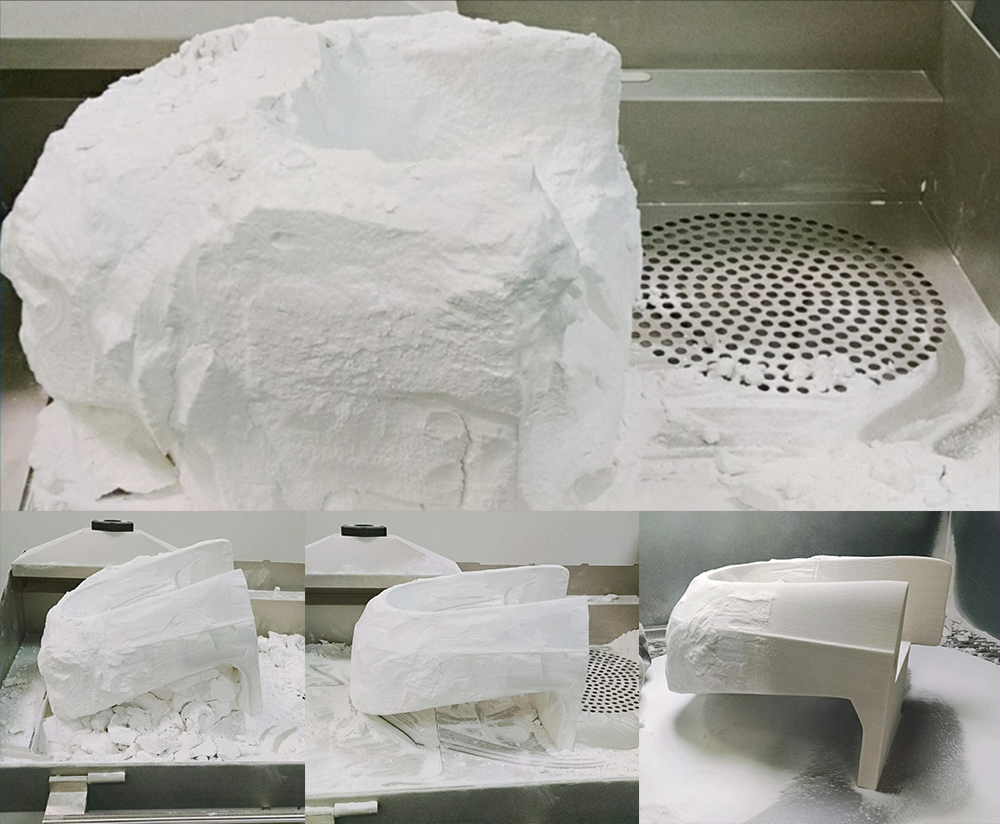FINESSING THE CURVES
Early in our Design process we noted that a lot of bumpers are flat framed, simple weld parts. We didn’t want a BOX that holds a SpeedHook™ and lights. If we wanted to honor Jeep’s classic lines, we needed more organic shapes. Our designers accomplished that with a tilt and slight backward curve. What appears to be simple to the untrained eye is actually quite complex.
Like Dave said – we’d have to proceed “as if we were making a piece of sculpture.” Tom achieved that with his 3D renderings; now, the best way to bring them to life was through 3D printing. We took Tom’s 3D models to a supplier that offers a process called rapid prototyping. That was a big jump, straight from a model to a 3D printed part. That 3D printed part would be assembled together with the welded, bent and fabricated parts to become one looks like prototype.
3D printing with Synergeering
Synergeering is about the closest an engineer can get to submitting data that results in a true production part without going into production. A company representative told us their clients include all the OEMs, tier 1 suppliers, “everybody that makes anything – power sports, rockets for NASA, anything and everything you can imagine.”
He said “The challenge on this project was the parts needed to be on a vehicle at SEMA. We’re firemen in the sense that we’re always there; in this case, we were able to turn mirrors and bumper ends for front and rear bumper around in less than four days. Our prototypes were constructed using RapidNylon® – a high end blend of glass filled nylon powder that creates parts with a satin-like finish with accuracies that are comparable to production thermoplastics.”

Parts are produced from CAD models using a modified additive manufacturing process called ‘laser sintering.’ Livescience.com explains, “One of the technologies used by today’s 3D printers is called selective laser sintering (SLS). During SLS, tiny particles of plastic, ceramic or glass are fused together by heat from a high-power laser to form a solid, three-dimensional object.”
Synergeering’s process uses a pair of CO2 lasers to sinter cross sections of parts layer by layer, 0.15mm at a time.
In addition to the visual accuracy of the end result, we were concerned about weight. They recommend 4mm wall thickness throughout, so parts are frequently hollowed out. That’s what we wanted.

FINISHING TOUCHES
It was up to Nick Stephey to get the parts painted and assembled the week before SEMA. “It hasn’t been easy. You can only rush the painters so much. You can’t hurry the drying.” But everything was feeling right. “When a supplier stopped by to drop off the mirrors, he said ‘I LOVE THOSE DOORS!'”
Crushing deadlines, weeks without rest – was it worth it? He said “Robert’s criteria were that the bumper be producible and that it be a bolt-on kit for the average user. The coolest part about it is the parts ARE fully manufacturable – it truly is a bolt on kit. You won’t see a lot of that at SEMA. A lot of the vehicles are one-offs, specific for that vehicle. This can be taken off and fit to any other Jeep Wrangler; unbolt and bolt.
There’s not a whole lot to be done because we spent time engineering right the first time. I’m very proud of that.” Ultimately “A lot of character flows with the vehicle. It almost has a factory look to it, like it could have been a factory option.”
He said at SEMA “I hope to shake the hands of people who love it.”
ARE WE THERE YET?
From the moment the doors closed at SEMA ’13, through the dust of Ultra4 King of the Hammers to the smoke and burning rubber at Jeep Beach, it was a challenge to find product Inspiration. When we found it, we had to envision it; creative, corporate and manufacturing pulled together for Design; and finally, exceptional talents from Hollywood, San Francisco, Ohio and the Motor City brought our concepts to Prototype. We’re proud of our work.
Like Halpin said “We had all kinds of good people working on the prototype. Every one gave us a good reason to modify. The guiding principle here was integrity of the design. We never compromised on that. That’s how we started out and we’ve been fighting that tooth and nail at every turn – fighting the desire to do it easier/faster/cheaper. Slight changes were made throughout the prototyping process, but the design remains true.”
The three stage journey has delivered us to our final destination: SEMA 2014. Will the products that came from these relationships – the miles traveled and the time spent – measure up to last year’s success? Were they worth the effort?
You tell us.
![Amanda Products [USA] Logo](https://www.amandaproducts.com/wp-content/uploads/2017/04/aplogo_nonretina.png)